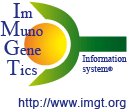Part 1 - Probe and clone availability
| TRGV subgroup | TRGV gene name |
Probe | Clone name | ATCC number | HGMP number | JCRB number | Accession number |
|---|---|---|---|---|---|---|---|
| 1 | TRGV1, TRGV2, TRGV3, TRGV4, TRGV5, TRGV5P, TRGV6, TRGV7, TRGV8 | VgammaI | pV3S [1] | 59592/59593 | 1188 | HG162 | M13430 |
| VgammaI-J (1) | S12SR [2] | 59590/59591 | 845 | HG161 | M13824/X03437 | ||
| 2 | TRGV9 | VgammaII | pV9PH [3] | 59596/59597 | 847 | HG164 | X07205 |
| VgammaII-J (2) | K20PR [1] | 59594/59595 | 846 | HG163 | M13823/X03436 | ||
| 3 | TRGV10 | VgammaIII-5' | pV10PR [3] | 59598/59599 | 848 | HG165 | X05503 |
| VgammaIII-3' | pV10RB [4] | 61218/61219 | 855 | HG205 | X07206 | ||
| mV10RB [4] | 59600/59601 | HG166 | |||||
| 4 | TRGV11 | VgammaIV-5' | pV11SPRS [4] | 59604/59605 | 849 | HG168 | X07207 |
| mV11SPRS [4] | 59602/59603 | HG167 | |||||
| A | TRGVA | TRGVA-5' | p5A6 [1] | 59606/59607 | 850 | HG169 | |
| TRGVA-3' | pVA0.6H [3] | 59608/59609 | 851 | HG170 | X07208 | ||
| B | TRGVB | TRGVB | pVB0.5KH [4] | 61224/61225 | 852 | HG200 | X07209 |
| mVB0.5KH [4] | 59614/59615 | HG173 |
Part 2 - Probe and clone characteristics
| Clone name | Gene content | Insert size (bp) | Restriction sites | Vector | Phage (3) | Cell line (4) | Comments |
|---|---|---|---|---|---|---|---|
| pV3S [1] | TRGV3 | 1200 | SacI | pUC | lambdaSH4 [1] | B cell line SH | Cross-hybridizes with all TRGV1 subgroup genes (V1, V2, V3, V4, V5, V5P, V6, V7, V8) |
| S12SR [2] | TRGV3-J2 | 1200 | SacI - EcoRI | pUC12 | lambdaS12 [1,2] | SUPT1 | |
| pV9PH [3] | TRGV9 | 700 | PstI - HindIII | pUC | lambdaSHV7 [3] | B cell lymphoblastoïd | |
| K20PR [1] | TRGV9-J1 | 1000 | PstI - EcoRI | pUC | lambdaK20 [2] | Karpas 1010 | A 410 bp PstI-AccI fragment isolated from K20PR contains TRGV9 (alone) and can be used as a VgammaII probe. [3,7] |
| pV10PR [3] | 5' part of TRGV10 | 600 | PstI - EcoRI | pUC | lambdaR12 [3] | RPMI 8402 | |
| pV10RB [4] | 3' part of TRGV10 | 400 | EcoRI - BamHI | pUC | lambdaJM15 [4] | JM | To get the insert, digest with EcoRI and HindIII (BamHI not reconstituted) |
| mV10RB [4] | M13 mp19 | ||||||
| pV11SPRS [4] | 5' part of TRGV11 | 270 | SphI - RsaI | pUC19 | lambdaJM15 [4] | JM | To get the insert, digest with EcoRI and HindIII |
| mV11SPRS [4] | M13mp19 | ||||||
| p5A6 [1] | 5' part of TRGVA and its 5' UTR | 2550 | SacI - HindIII | pUC19 | lambdaA6 [1] | AT5B1 | SacI is a vector site |
| pVA0.6H [3] | 3' part of TRGVA and its 3' UTR | 600 | HindIII | pUC | lambdaA6 [1] | AT5B1 | |
| pVB0.5KH [4] | 3' part of TRGVB and its 3' UTR | 500 | KpnI - HindIII | pUC | lambdaJM15 [4] | JM | |
| mVB0.5KH [4] | M13 |
Part 3 - Main probe uses
In this table, are shown for each gene, the most appropriate probes to use for TRG gene rearrangements, for RFLP, and for TRG gene expression analyses. Probes are designated by their clone names. Several probes are available in both pUC and M13 (names starting with "p" or "m", respectively). Note that clones in pUC are easier to handle and to grow than clones in M13. Click on the clone names for more information on TRG gene rearrangements and on RFLP data.
| TRGV subgroup | TRGV gene name |
For TRGV gene rearrangements | For RFLP | For TRGV gene expression |
|---|---|---|---|---|
| 1 | TRGV1, TRGV2, TRGV3, TRGV4, TRGV5, TRGV5P, TRGV6, TRGV7, TRGV8 | pH60 [7] | pV3S [8,9,12] | pV3S |
| 2 | TRGV9 | pH60 [7] | pV9PH [13] | pV9PH |
| 3 | TRGV10 | pH60 [7] | pV10PR | |
| 4 | TRGV11 | pH60 [7] | pV11SPRS, mV11SPRS [10,11] | pV11SPRS |
| A | TRGVA | p5A6, pVA0.6H | ||
| B | TRGVB | pVB0.5KH, mVB0.5KH |
| (1) | The clone S12SR contains a rearranged V3-J2 gene. |
| (2) | The clone K20PR contains a rearranged V9-J1 gene. |
| (3) | Phages from which have been isolated the clones used as probes. |
| (4) | Human cell lines from which DNA was extracted for construction of the phage genomic libraries. They are either alpha-beta T cell or B cell lines. Note that all the data on the TRG genes have been obtained from cells which do not express the TcR gamma-delta receptor. When cell lines expressing the TcR gamma chain have been identified [Brenner, M.B et al., Nature, 322, 145-149 (1986)], the whole of the data on the TRG gene organisation and rearrangement obtained in alpha-beta T cells and B cells [1,2,5,6],has been shown to be valid for gamma-delta T cells. |
| [1] | Lefranc, M.-P. et al., Cell, 45, 237-246 (1986). |
| [2] | Lefranc, M.-P. et al., Nature, 319, 420-422 (1986). |
| [3] | Foster, A. et al., EMBO J., 6, 1945-1950 (1987). |
| [4] | Huck, S. et al., EMBO J., 7, 719-726 (1988). |
| [5] | Lefranc, M.-P. and Rabbitts, T.H., Nature, 316, 464-466 (1985). |
| [6] | Lefranc, M.-P. et al., Proc. Natl. Acad. Sci. USA, 83, 9596-9600 (1986). |
| [7] | Huck, S. et Lefranc, M.-P., FEBS lett., 224, 291-296 (1987). |
| [8] | Font, M.-P. et al., J. Exp. Med., 168, 1383-1394 (1988). |
| [9] | Ghanem, N. et al., Immunogenetics, 30, 350-360 (1989). |
| [10] | Ghanem, N. et al., Nucleic Acids Res., 17, 1270 (1989). |
| [11] | Ghanem, N. et al., Nucleic Acids Res., 17, 1271 (1989). |
| [12] | Ghanem, N. et al., Hum. Genet., 86, 450-456 (1991). |
| [13] | Martinez-Naves, E. et al., Nucleic Acids Res., 19, 5806 (1991). |



